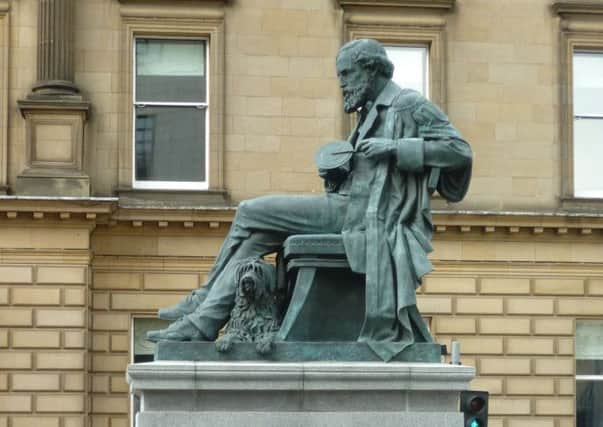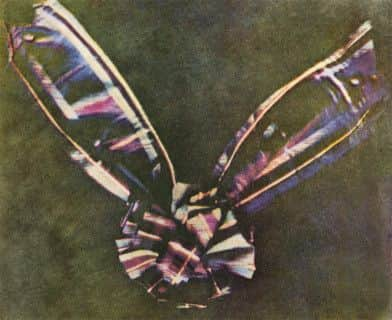Lost Edinburgh: James Clerk Maxwell


When it comes to discussing the greatest ever minds in the field of physics, the name of James Clerk Maxwell may not be as readily familiar as the likes of Einstein and Newton, but here was a man whose theories and discoveries made him equally as important in shaping the modern world.
Early years
Maxwell was an Edinburgh man. He was born on 13 June 1831 in a house built for his father at 14 India Street in the city’s upmarket and burgeoning New Town. When Maxwell was still a young boy, the family upped sticks to Glenlair House, Dumfries & Galloway. It was here that Maxwell first displayed signs of his innate inquisitiveness, forever posing questions regarding the nature of the things around him. Utterances such as “What does it do?” or “What’s the go o’ that?” were seldom far from his lips.


Advertisement
Hide AdAt the age of 10, Maxwell was back in the Scottish capital living with his aunt at 31 Heriot Row, a stone’s throw from his birthplace. He was receiving his education at Edinburgh Academy where he would excel – despite enduring a rather tough initiation process. On his first day at the school, Maxwell was taunted for his countrified dress sense and returned home that day with ‘his tunic in rags, and his neat frill rumpled and torn’. Maxwell’s eccentricity and unique way of seeing the world earned him the nickname ‘dafty’. Little did his classmates know what he would one day go on to achieve.
First scientific paper
By the age of 15, Maxwell was already a deeply accomplished student of mathematics and published his first scientific paper ‘Oval Curves’, which was read out by Professor Forbes to the Edinburgh Royal Society. The young mathematician was progressing with ease.
In 1847 he entered the University of Edinburgh where two further scientific papers earned him a move to Peterhouse College, Cambridge and then Trinity College in 1850. Maxwell graduated with a degree in mathematics and between 1856-60 he served as Professor of Natural Philosophy at Aberdeen’s Marischal College. It was during this time that Maxwell worked on a quandary which had flummoxed scientists for over 200 years: the true nature of the rings of Saturn and how they remained in position. He concluded that the rings must be composed of numerous small particles, each independently orbiting the planet. These predictions would be confirmed in observations made by NASA’s Voyager space probe well over a century later.
In 1860 Maxwell was installed as professor at the King’s College, London where he would embark on the most fruitful chapter of his illustrious career.
The world’s first colour photograph
In 1861 Maxwell helped to produce what is considered to be the world’s first ever colour photograph. Maxwell had figured out that colour is produced, not of the three primaries, but from red, green and blue. Photographer Thomas Sutton and Maxwell took three separate images of a tartan ribbon each using a different coloured filter and then combined and projected the images together to produce a full colour representation. The three original photographic plates can be seen today at the Maxwell museum at 14 India Street in Edinburgh, the house where he was born.
Studies on electromagnetism
Between 1864 and 1873 Maxwell expanded on the work of Michael Faraday to produce what are undoubtedly his crowing achievements.
Advertisement
Hide AdMaxwell’s elaborate studies on electromagnetism were truly ground-breaking. They diverged from the traditional Newtonian view and heralded an era of seemingly limitless possibilities. Maxwell’s most significant work, A Dynamic Theory of the Electromagnetic Field, was published in 1865. In the Scot’s own words to the Royal Society, he exclaimed: “We have strong reason to conclude that light itself - including radiant heat and other radiation, if any - is an electromagnetic disturbance in the form of waves propagated through the electro-magnetic field according to electro-magnetic laws.”
Maxwell’s discoveries of the laws of electrodynamics sparked a revolution. The presence of modern-day electronics, radio, television, mobile phones, the internet, would not have been possible if it had not been for the pioneering work of a man once nicknamed ‘dafty’ by his classmates. Albert Einstein himself is quoted as saying that he stood ‘not on Newton’s shoulders, but on Clerk Maxwell’s’. James Clerk Maxwell was a true giant of mathematical physics.
Recognition
Advertisement
Hide AdSince James Clerk Maxwell’s death from stomach cancer aged just 48 in 1879, suitable recognition of his considerable achievements and his impact upon the advances of the 20th century has been sorely lacking. In the 1999 Millennium Survey of the most prominent physicists of all time, Maxwell was voted third behind Isaac Newton and Albert Einstein. However, in Edinburgh, the scene of Maxwell’s birth and early education, his name is rarely mentioned and relatively unknown.
The city finally managed to erect a statue of the great man in 2008. Designed by esteemed architect, Alexander Stoddart, it sits proudly at the eastern end of George Street. Considering everything Maxwell has given to the modern world, the recognition has been due for quite some time.
FOLLOW US
SCOTSMAN TABLET AND MOBILE APPS